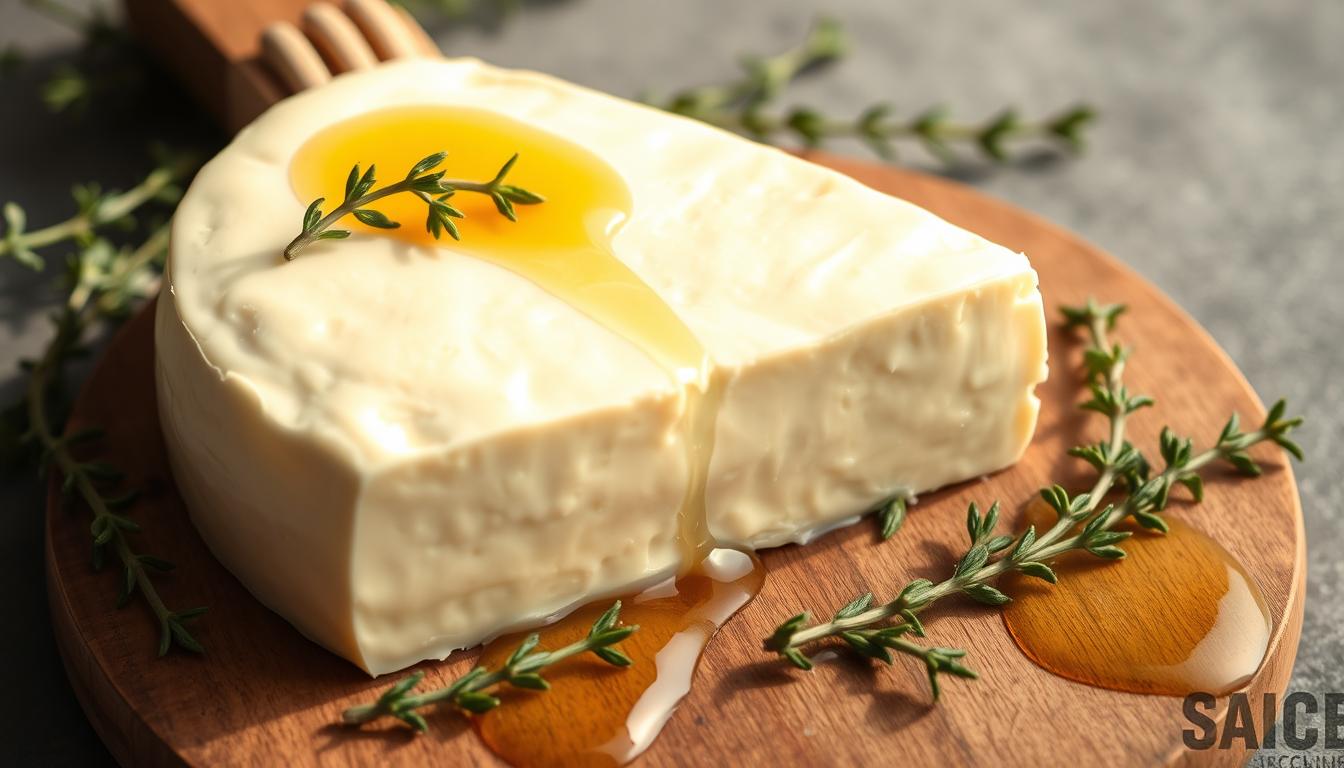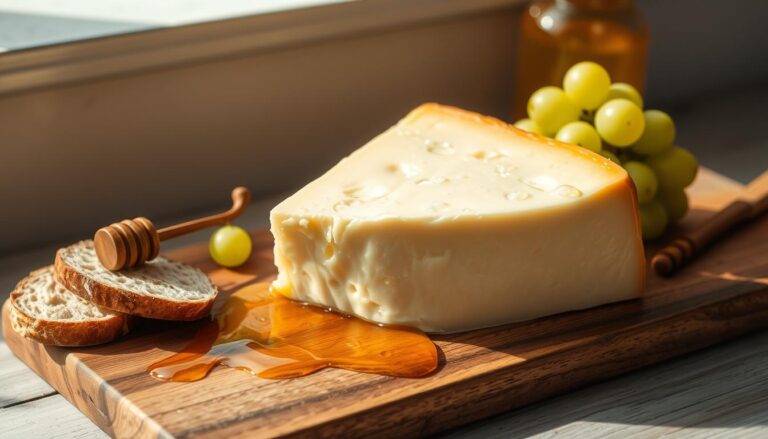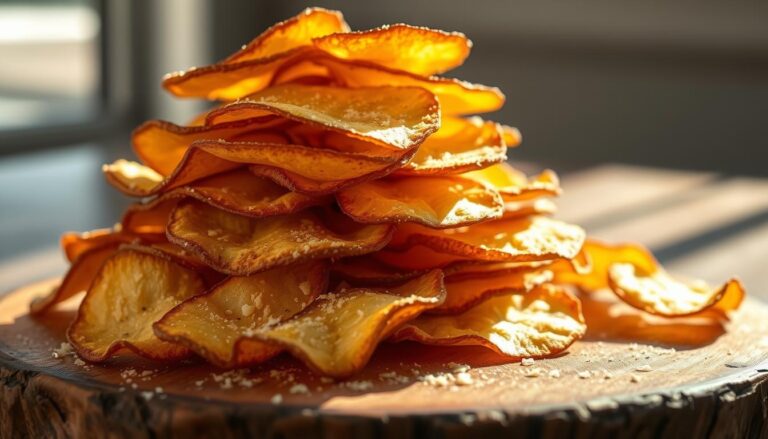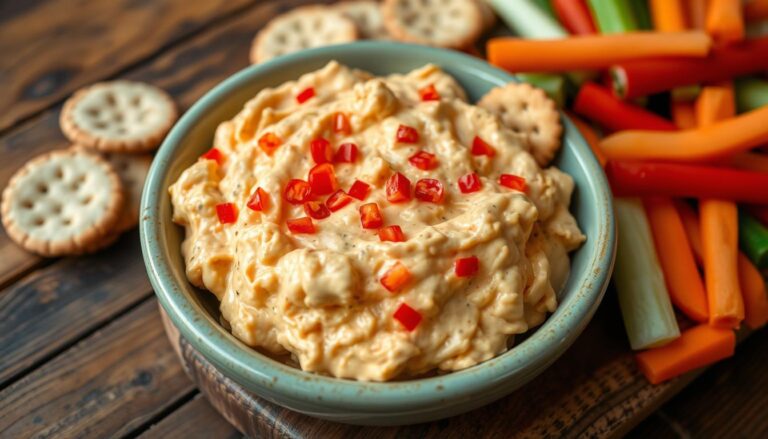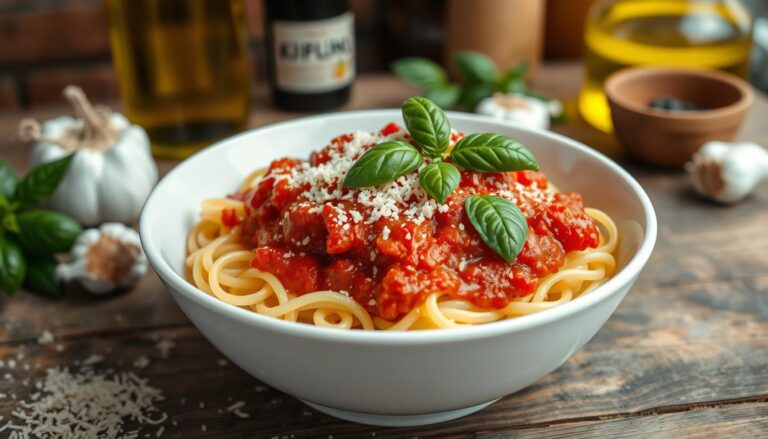Creamy Mascarpone: Your New Favorite Ingredient
Mascarpone cheese is a type of Italian cheese. It’s made from cream and citric acid. It’s known for its rich, creamy texture and mild flavor. This makes it a great ingredient to learn about, like when comparing Mascarpone vs Cream Cheese1.
Knowing what Mascarpone Cheese is? is key to using it in cooking and baking. It’s versatile and can be used in many dishes, from desserts to savory sauces2.
When looking at Mascarpone vs Cream Cheese, mascarpone stands out. Its whipped cream can be made in just 5 minutes2. Mascarpone cream can also be made quickly, in 15 minutes or less. The traditional recipe includes eggs, sugar, and sometimes rum1.
Key Takeaways
- Mascarpone cheese is made from cream and citric acid.
- It has a rich, creamy texture and mild flavor.
- Mascarpone is versatile and can be used in various dishes.
- Preparation time for whipped mascarpone cream is 5 minutes2.
- Mascarpone cream can be made in 15 minutes or less1.
- Understanding what is Mascarpone Cheese? is crucial for exploring its uses.
- Mascarpone vs Cream Cheese comparison is essential for choosing the right ingredient1.
What is Mascarpone Cheese?
Mascarpone cheese is a type of Italian cheese made from cream and citric acid. It has a rich, spreadable texture3. It’s often used in desserts like tiramisu and is a key ingredient in many Italian recipes. Mascarpone has a higher fat content and a more delicate flavor compared to cream cheese.
Mascarpone cheese has a long history in Italy, where it originated in Lombardy3. The production process involves heating cream and adding citric acid. This results in a smooth, creamy texture. This process is labor-intensive, which makes mascarpone cheese more expensive than other types of cheese.
In terms of nutritional content, mascarpone cheese contains about 120 calories per tablespoon3. It has a high fat content, mostly saturated fat. It’s classified as a triple-cream cheese, showing its high-fat content. For more information on mascarpone cheese, visit the Wikipedia page on Mascarpone.
Overall, mascarpone cheese is a unique and versatile ingredient. It has a rich history and cultural significance in Italian cuisine. Its high fat content and delicate flavor make it a key component in many recipes, from desserts to savory dishes.
The Unique Properties of Mascarpone
Mascarpone is a versatile ingredient for both sweet and savory dishes. It’s a great addition to many Best Desserts with Mascarpone recipes4. Its high butterfat content, up to 75 percent, gives it a rich and creamy texture5. This makes it a perfect substitute for whipped cream, offering a richer taste with a tangy flavor4.
When using mascarpone in desserts, it’s often mixed with other ingredients for a balanced taste. It can top fruit, frost cakes, or thicken soups5. Mascarpone’s acidity is milder than cream cheese and ricotta, making it ideal for tiramisu4. With about 450 calories per 100 grams, it’s a rich ingredient to use sparingly6.
Here are some key characteristics of mascarpone:
- High butterfat content: up to 75 percent5
- Rich and creamy texture4
- Less acidic than cream cheese and ricotta cheese4
- Approximately 450 calories per 100 grams6
Mascarpone vs. Other Creamy Cheeses
Mascarpone is often compared to cream cheese and ricotta. Mascarpone has a fat content of up to 75%7. Cream cheese, on the other hand, has a minimum of 33% milk fat7 and 30% to 40%8. This makes mascarpone richer and creamier, perfect for desserts like tiramisu.
Cream cheese is often used in savory dishes. But mascarpone is great for both sweet and savory dishes8. If you want to substitute cream cheese with mascarpone, mix in up to 1/4 cup of heavy whipping cream per 8 oz. of cream cheese9. But remember, mascarpone has a unique taste that’s hard to match with other cheeses.
Here are some key differences between mascarpone and other creamy cheeses:
- Mascarpone has a higher fat content than cream cheese, with a range of 60% to 75%8
- Cream cheese has a lower fat content, with a range of 30% to 40%8
- Mascarpone is made from heavy cream, while cream cheese is made from whole milk8
For more info on cheese, visit cheesevibes.com. Learn about different cheeses and their uses in cooking and baking.
Nutritional Profile and Health Benefits
Mascarpone cheese is loved for its creamy texture. It’s a key ingredient in many dishes. The question Is Mascarpone Cheese Keto-Friendly? leads us to look at its nutrition. Nutrition facts show it has 429 kCal of energy per 100g, 7.14g of protein, and 50g of fat10. Its high fat content is good for a keto diet.
Mascarpone cheese also has calcium, which helps prevent kidney stones. It binds with oxalate in the stomach and intestines10. Plus, it helps absorb vitamins A, D, E, and K10. But, it’s important to watch the calories and fat, as it has 429 calories per 100 grams11.
Here are some key nutritional benefits of mascarpone cheese:
- High in fat, making it suitable for a keto diet
- Good source of calcium, which can help prevent kidney stones
- Aids in the absorption of fat-soluble vitamins
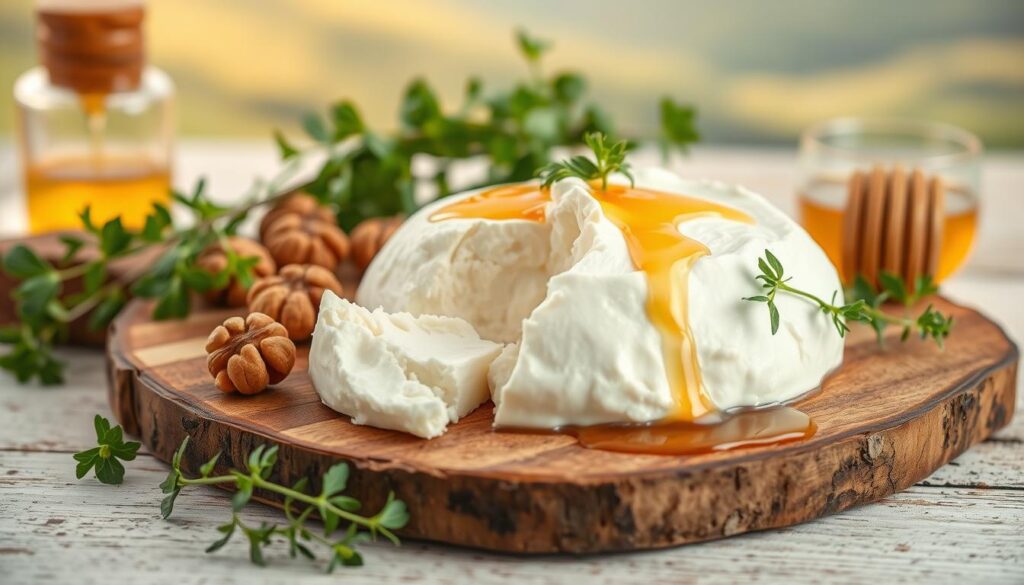
Mascarpone cheese can be a healthy part of a balanced diet, great for keto diets. Its fat and calcium are valuable. But, it’s important to eat it in moderation because of its high calorie count11.
How to Make Mascarpone at Home
Making mascarpone at home is easy. You need heavy cream and lemon juice12. Start with 2 ½ cups of heavy cream and 2 ½ tablespoons of lemon juice12.
Heat the cream to 185°F (85°C)13. Then, cool it to 140°F (60°C)13. Strain it and refrigerate for 24 hours13.
To make mascarpone, heat the cream, cool it, and strain it12. The cream must have at least 30% fat13. You’ll get about 1 to 1.5 cups of mascarpone13. It keeps in the fridge for up to 4 days12.
Here’s what you need to make mascarpone at home:
- 16 ounces of whole cream (with at least 30% fat)13
- ½ tablespoon of lemon juice13
- A medium saucepan
- A strainer
- A bowl
For more info on sweet cheese crepes, check out this website. With these steps and ingredients, you can make tasty mascarpone at home. Enjoy it in sweet treats or savory dishes12.
Classic Dessert Applications
Mascarpone is a key ingredient in many classic Italian desserts, including tiramisu and cannoli14. It’s a must-have for Best Desserts with Mascarpone. For instance, a classic tiramisu recipe needs 230 g of mascarpone cheese, 1 ⅓ cups of heavy cream, and 1 cup of powdered sugar15.
Some popular dessert recipes that feature mascarpone include cheesecakes, trifles, and fruit tarts. These desserts often have high star ratings, with an average of 4.6 out of 516. The use of mascarpone in these desserts adds a rich and creamy texture, making them perfect for special occasions.
Here are some examples of Best Desserts with Mascarpone:
- Tiramisu: a classic Italian dessert made with ladyfingers, mascarpone cheese, and espresso
- Cannoli: a Sicilian dessert consisting of fried pastry shells filled with sweetened mascarpone cheese
- Cheesecakes: a creamy dessert that often features mascarpone as a key ingredient
Mascarpone’s fat content ranges between 60% and 75%14, making it an ideal ingredient for desserts that require a rich and creamy texture. With its versatility and delicious flavor, mascarpone is a great addition to many Best Desserts with Mascarpone14.
Savory Dishes Featuring Mascarpone
Mascarpone cheese is great for many savory dishes. It’s perfect for pasta, risotto, sauces, spreads, and appetizers. Its high fat content, at least 40%17, makes it a good substitute for cream cheese or sour cream. It turns pasta or risottos into silky sauces17.
Try Cacio e Pepe Spaghetti with 5 oz of mascarpone18, or Salmon Millefoglie with 1 1/2 cup18. These recipes show mascarpone’s versatility in creamy and refreshing dishes. It also makes savory tarts creamier, adding flavor to vegetables and herbs17.
For new Savory Mascarpone Cheese Recipes, mix mascarpone with prosciutto, pears, and red onion for a sweet and savory taste17. Mascarpone also makes scrambled eggs creamier without extra cooking time17. Its mild flavor and high fat content make it perfect for many dishes, limited only by your creativity.
Here are some ideas for savory dishes featuring mascarpone:
- Pasta and risotto recipes, such as Cacio e Pepe Spaghetti18
- Sauces and spreads, like a mascarpone-based dip for vegetables17
- Appetizer ideas, such as a mascarpone and prosciutto tart17
Mascarpone’s rich and creamy texture is great in many savory dishes. It’s perfect for making delicious Savory Mascarpone Cheese Recipes. Whether you’re enhancing a classic pasta dish or inventing a new appetizer, mascarpone will impress.
Storing and Handling Mascarpone
To keep mascarpone fresh, store it in the fridge at 34°F to 39°F19. This keeps it quality and prevents spoilage. Unopened mascarpone can last up to 2 weeks in the fridge19. But, once opened, use it within a week19.
For those looking for Mascarpone Cheese Substitutes, knowing how to store and handle it is key. Mascarpone can be frozen, but freezing may change its texture19. When freezing, use an airtight container or freezer-safe plastic bag, and remove air20.
Here are some key storage and handling tips for mascarpone:
- Store in the refrigerator at a temperature between 34°F and 39°F19
- Use within a week of opening19
- Freeze in an airtight container or freezer-safe plastic bag20
- Avoid freezer burn by removing as much air as possible20
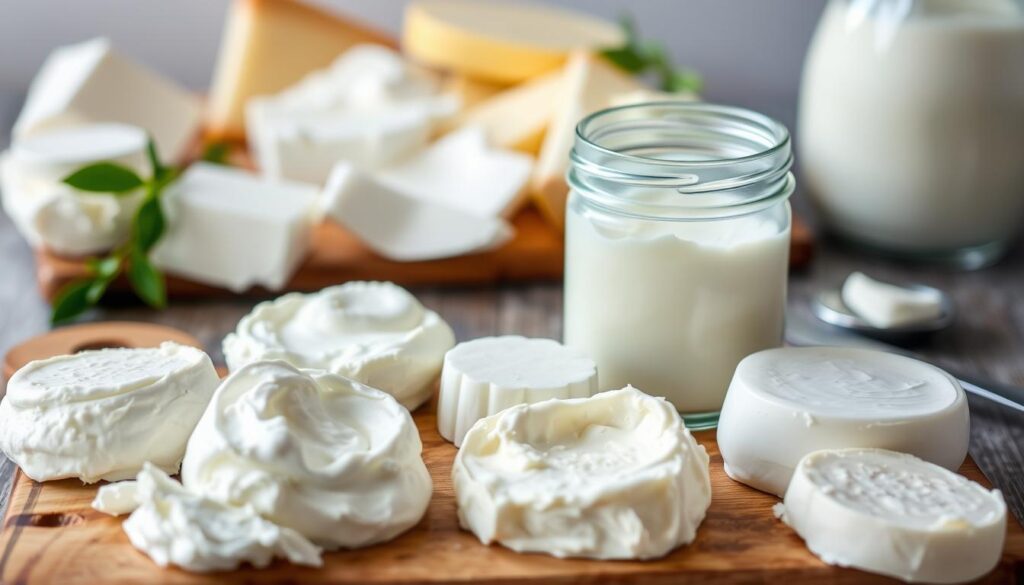
By following these guidelines, your mascarpone will stay fresh and high quality. It’s perfect for many dishes, including those with Mascarpone Cheese Substitutes.
Common Substitutes for Mascarpone
Finding a substitute for mascarpone cheese can be tricky. But, there are many options, including dairy and vegan choices. Mascarpone Cheese Substitutes work well in both sweet and savory dishes.
Dairy alternatives like sour cream, ricotta, and crème fraîche are good substitutes. They have a similar texture to mascarpone and can replace it in many recipes21. Full-fat Greek yogurt and cottage cheese also work well, offering a creamy feel22.
For vegans, there are great alternatives too. Silken tofu, cashew cream, and coconut cream can mimic mascarpone’s creaminess and mild taste21. These options are perfect for those with dietary restrictions and can be used in a variety of dishes22.
Here are some popular Mascarpone Cheese Substitutes:
- Sour cream
- Ricotta cheese
- Crème fraîche
- Full-fat Greek yogurt
- Cottage cheese
- Silken tofu
- Cashew cream
- Coconut cream
Tips for Cooking with Mascarpone
Understanding mascarpone’s unique properties is key when cooking with it. It’s a high-fat cheese, with about 60% fat content23. This makes it ideal for creamy desserts and sauces. To make mascarpone at home, heat cream to 185 degrees Fahrenheit and add tartaric acid24.
Mascarpone is a favorite in desserts like tiramisu, often mixed with marsala wine23. It’s also great for creamy pasta sauces, like the quick recipe on momsdinner.net. Remember, 8 ounces of mascarpone is about 1 cup or 225 grams25.
Here are some tips for cooking with mascarpone:
- Use high-quality ingredients, such as fresh cream and real vanilla extract, to get the best flavor out of your mascarpone dishes.
- Don’t overmix mascarpone, as it can become too stiff and separate25.
- Experiment with different flavor combinations, such as pairing mascarpone with fruit or nuts, to create unique and delicious desserts.
By following these tips and understanding mascarpone, you can make a variety of tasty dishes. From creamy pasta sauces to decadent desserts, mascarpone adds richness and versatility. Learning how to make mascarpone at home is a fun and rewarding experience.
Pairing Mascarpone with Other Ingredients
Mascarpone is a versatile cheese that can be paired with many ingredients. For sweet treats, it’s great with fruit like strawberries or blueberries for a tangy dessert26. It also pairs well with chocolate for a rich, decadent treat26.
For savory dishes, mascarpone works well with herbs and spices like basil or garlic. It makes a flavorful sauce for pasta or risotto27. It can also replace butter or cream in soups and sauces, adding a creamy texture27.
Some popular Savory Mascarpone Cheese Recipes include pasta dishes like Pasta Salmone e Mascarpone. This dish uses mascarpone with hot pasta water for a smooth sauce27. Mascarpone also makes creamy soups, like creamy tomato soup, by substituting for butter and cream27.
For those wanting to make their own Best Desserts with Mascarpone, there are many recipes and tutorials online26. Mascarpone’s rich and creamy texture makes it perfect for a variety of dishes. It can be used in both sweet treats and savory meals28.
Conclusion
As we wrap up our journey into the world of mascarpone, it’s clear this cheese is a true treasure. Its29 rich, velvety texture and30 indulgent taste make it a must-have in many dishes. From the famous30 tiramisu to creamy30 pasta sauces, mascarpone is a kitchen staple.
Whether making a sweet treat or adding luxury to savory dishes31, mascarpone shines. Its29 high-fat content gives dishes a creamy feel. Its29 mild taste lets it mix well with other ingredients. You can use it with fresh berries or in roasted vegetable dishes, showing its endless uses.
We invite you to keep exploring with mascarpone in your cooking. Whether you’re a pro chef or a home cook, this31 versatile cheese will quickly become a favorite.
FAQ
What is Mascarpone Cheese?
Mascarpone is a soft, creamy cheese from Italy. It’s rich and velvety, with a mild, sweet taste.
How does Mascarpone differ from Cream Cheese?
Mascarpone is creamier and richer than cream cheese. It has a higher fat content and a milder flavor.
What are the best desserts to make with Mascarpone?
Mascarpone is great in Italian desserts like tiramisu and cannoli. It’s also perfect for cheesecakes, fruit tarts, parfaits, and crepes.
Can I make Mascarpone at home?
Yes, making mascarpone at home is easy. You need just a few ingredients and patience. It involves heating and curdling cream, then straining it.
Is Mascarpone Cheese Keto-Friendly?
Yes, mascarpone is keto-friendly. It’s high in fat and low in carbs. It’s great for keto desserts and dishes.
What can I use as a substitute for Mascarpone Cheese?
You can use cream cheese, ricotta, or crème fraîche as substitutes. Heavy cream and cream cheese mixtures also work. Vegan options include cashew cream or coconut-based cheese alternatives.
What are some savory recipes that use Mascarpone Cheese?
Mascarpone is versatile in savory dishes. It’s good in pasta sauces, risottos, pizza, and dips. It adds a creamy texture and subtle flavor.

